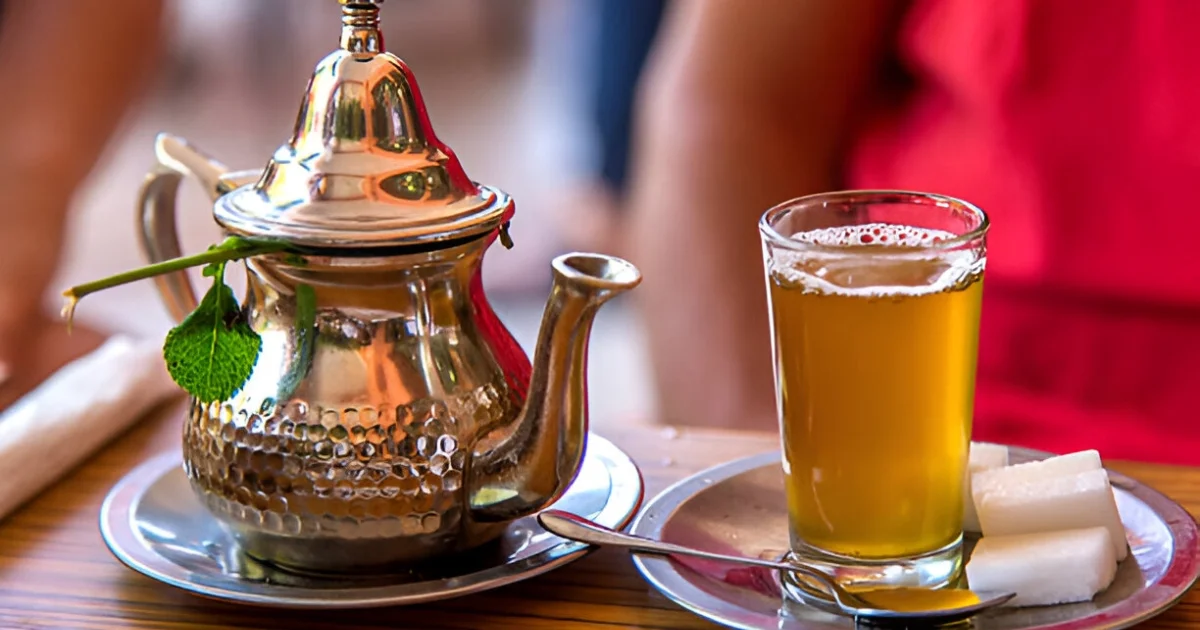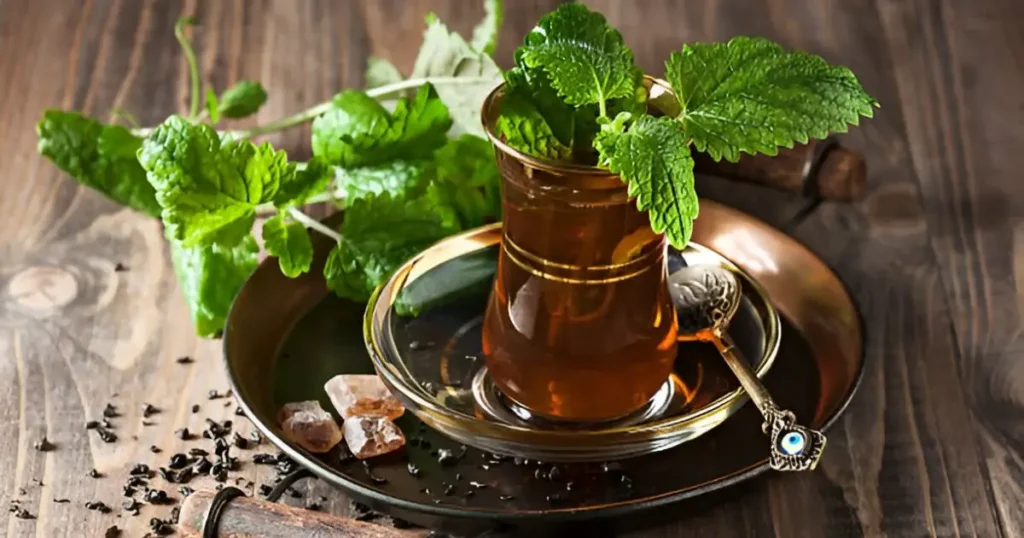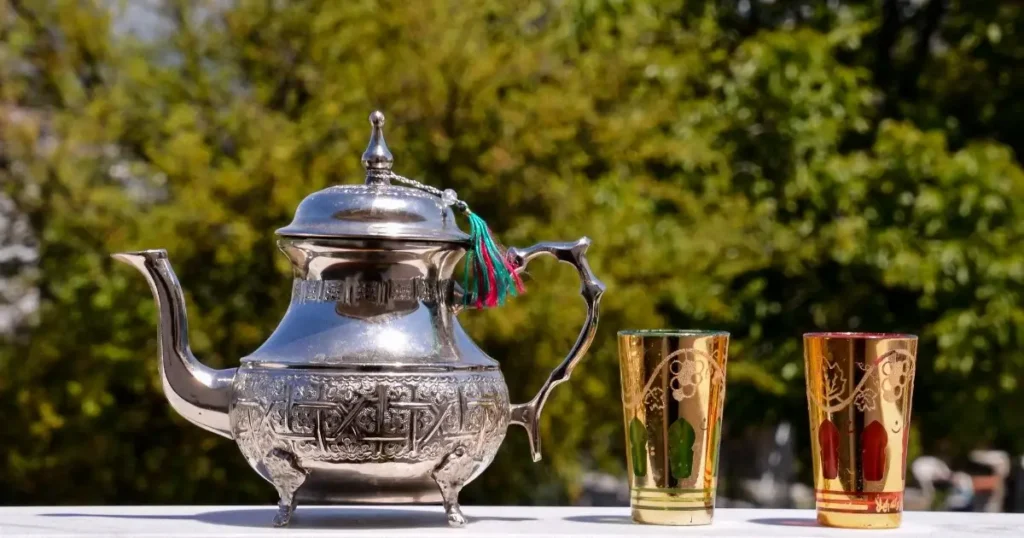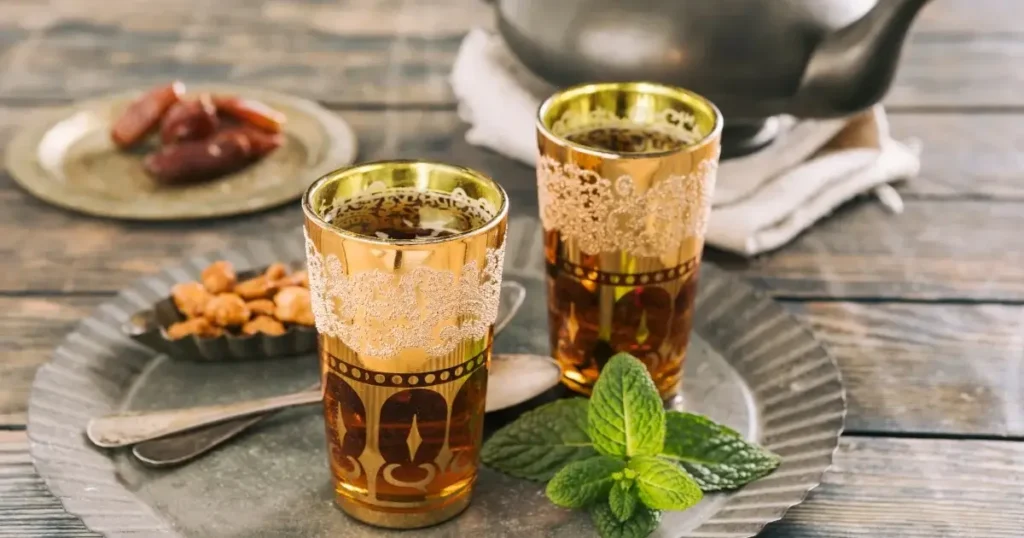Enjoy free and fast shipping on all your orders
How to Make Authentic Moroccan Mint Tea and Why It’s Good for You

Introduction: The Enchanting World of Moroccan Mint Tea
Step into a world where Moroccan Mint Tea is more than a drink it’s a warm welcome in a glass. Whether you name it mint tea Moroccan style or just Moroccan tea, this infusion of green tea, fresh mint leaves, and a dash of sweetness has mesmerizing sippers for generations.
Every pour from the famous “Berrad” teapot seems to be an invitation to calm down, savor life, and connect with an ancient legacy. Ready to reveal the secrets of creating “liquid hospitality” from this brew? Let’s start now.
Table of Contents
The Rich History Behind Moroccan Tea Drink
Ancient Origins: How Mint Tea Became Morocco’s Cultural Icon
Berber tribes crossing the Atlas Mountains found the energising effect of mint leaves steeped in green tea long before Morocco’s famous souks and kasbahs emerged. Trade caravans from China and India carried green tea leaves across the Sahara by the eighteenth century, therefore combining Eastern tea culture with North African hospitality. A monument to its strong roots in Moroccan life, around 8 million moroccan mint tea cups are drank everyday across the kingdom today.
The Symbolism and Social Significance of Tea Ceremonies
Pouring tea is a ritual of respect rather than a daily task in Morocco. the three consecutive pours represent life, love, and death, so reminding hosts and guests of their path in life. Getting a drink of Moroccan Mint Tea indicates trust, friendship, and respect. In palaces and villages alike, the act of distributing tea cements links generations.

Essential Ingredients: The Perfect Blend
Creating an authentic tea moroccan experience hinges on three core elements:
- Green Tea Base
- Fresh Mint Leaves
- Sweetener (Traditional or Alternative)
Selecting the Ideal Green Tea Base
- “Al Baroud” Tea: Rolled pellets that unfurl into full leaves, providing a somewhat smokey, strong taste.
- Sencha: sometimes known as Chun Mee, lighter vegetal qualities that highlight freshness of mint.
“AL Baroud” tea is forgiving for beginners; its powerful taste won’t fade if your water is a little too hot or if brew time runs long.
Choosing Fresh Mint Varieties That Make a Difference
- Nana Mint (Mentha spicata var. crispa): Broad leaves and a pleasant, gentle scent define this traditional Moroccan option.
- Spearmint: Slightly more sharp taste, generally readily accessible.
- Chocolate Mint or Pineapple Mint: Not often used but surprising and delicious.
Choose always vivid green, aromatic leaves free of imperfections. One can verify peak freshness with a basic sniff test.
The Sweet Element: Traditional Sugar Choices and Alternatives
| Sweetener | Flavor Profile | Why it works |
| White Granulated Sugar | Clean, neutral sweetness | Dissolves quickly and highlights mint’s freshness |
| Cane Sugar (Unrefined) | Subtle molasses notes | Adds a gentle caramel depth that complements green tea |
| Honey or Agave Syrup | Floral, fruity nuance | Traditional in Saharan regions; pairs beautifully with mint’s menthol lift |
| Stevia or Erythritol | Zero-calorie, neutral | Great if you’re watching sugar intake—just be mindful of aftertastes |
Start with one to two teaspoons of your preferred sweetener per 250 millilitres (one cup) of tea and then taste-adjust. After the first pour, carefully stir to mix sweetness without breaking the top foam.
The Art of Preparation: Traditional Methods Unveiled
Special Teapots: Understanding the Importance of the Berrad
The “berrad”, a thin, beautifully ornamentated metal teapot, is your gateway to real Moroccan tea with mint, Its tall, narrow spout creates the dramatic “high pour,” aerating the tea, building foam, and releasing aromatic oils.
The High Pour Technique: Mastering the Iconic Serving Method
- First Pour: From teapot to glass, then back rinses the leaves.
- Second Pour: Builds a light foam, signaling a gentle infusion.
- Final Pour: Height and force deepen the flavor and settle the foam.
For the characteristic foamy layer, aim for at least 30 cm of vertical drop on the second and third pours.
Temperature Control: The Secret to Perfect Infusion
- Water Temperature: 80–85 °C, somewhat below boiling point.
- Steep Time: 2-3 minutes for the first infusion, up to 5 minutes for subsequent brews.
Too chilly tastes weak; too hot water scorches the leaves, rendering your moroccan mint tea harsh.

Regional Variations Across Morocco
Northern Mountain Style: The Refreshing Rif Approach
Sippers in the Rif Mountains sometimes add wild mountain herbs like oregano or sage to create a moroccan tea blend with a herbaceous and energising effect.
Desert Traditions: How Saharan Communities Adapt Their Brew
Offering energy and hydration in desert settings, bedouin-style mint tea substitutes roasted gunpowder mint tea pellets for green tea and stirs in dates or date syrup for sweetness.
Coastal Influences on Tea Preparation
Sometimes citrus peels (orange or lemon) are added to mint tea moroccan infusions along the Atlantic coast to provide zesty brightness and a beach flair.
Health Benefits Hidden in Your Teacup
Digestive Properties and Traditional Medicinal Uses
For decades, Moroccans have drank mint tea to help digest heavy meals. While warm beverages soothe the belly, menthol in mint helps to relax stomach spasms.
Antioxidant Power of Green Tea and Fresh Mint
- Up to 20% of green tea catechins help to lower oxidative stress.
- Mint’s menthol and rosmarinic acid have anti-inflammatory action, therefore relieving muscular tension and headache pain.
Modern Science Confirms Ancient Wisdom: Recent Studies
Regular use of moroccan mint tea improves blood vessel function by 15%, hence increasing cardiovascular health according to a 2023 research. Including a daily cup helps body and mind.
The Etiquette of Moroccan Tea Service
Three Cup Tradition: “The first glass is as gentle as life, the second as strong as love, the third as bitter as death”
Accept the symbolism inherent in every pour:
- First Cup: An introduction, light and moderate.
- Second Cup: Strong, full-bodied honours friendship.
- Third Cup: Slightly astringent acknowles difficulties of life.
Hosting Guests: Proper Serving Practices and Customs
- Pour always from a standing position.
- Hold the “berrad” by its handle and gently press the lid with your thumb.
- Offer refills until your guest declines, twice is considered courteous.
Reading the Leaves: Traditional Fortunes and Superstitions
The way the leaves line the glass after the last drink can predict one’s future. Wavy lines may indicate approaching travel; clustered fragments suggest a planned reunion.
Creating Your Authentic Experience at Home
Essential Tools for Your Moroccan Tea Collection
- Berrad Teapot (metal, long spout)
- Small Tea Glasses (clear, tulip-shaped)
- Tea Tray and Tea Strainer (for clean pours)
Step-by-Step Brewing Guide for Beginners
- Rinse: Boil water; fill your berrad; pour into glasses; discard.
- Brew: Add 1 tbsp of green tea base + handful of mint; pour hot water; steep 2 minutes.
- Sweeten: Stir in sugar or honey to taste.
- Serve: Perform the three-pour ritual; garnish with fresh mint sprigs.
Common Mistakes to Avoid When Making Moroccan Mint Tea
- Overcrowding the Teapot: Leaves require space to unfold.
- Skipping the Rinse: Leads to gritty, dusty flavor.
- Boiling Water: Burns leaves, creating bitterness.
Modern Twists on a Timeless Classic
Contemporary Variations: Iced Moroccan Mint Tea
Chill your Moroccan mint tea recipe and serve over ice with a slothful of citrus or sparkling water for effervescence for hot regions or summer days.
Culinary Applications: Cooking and Baking with Mint Tea Flavors
- Moroccan Tea-Infused Syrup: Drizzle over pancakes or fruit salads.
- Mint Tea Granita: Freeze sweetened brew into icy, slushy goodness.
- Tea-Poached Pears: Simmer fruit in a spiced green Moroccan mint tea blend.
Fusion Drinks: Moroccan Mint Tea Cocktails and Mocktails
- Mint Tea Mojito: Swap rum for pomegranate juice and chilled mint tea moroccan.
- Spiced Tea Sangria: Mix mint tea with red wine, orange slices, and cinnamon sticks.

Conclusion
From its legendary background to its surprising health benefits, Moroccan Mint Tea is evidence of the potency of basic ingredients and careful ritual.
Every cup asks you to slow down, connect, and savour life’s little events from perfecting the high pour to investigating tea moroccan regional variations to creating a cool iced Moroccan mint tea.
Prepare your tools, follow our advice, and let the magic of Moroccan mint tea benefits to turn your next tea break into a remarkable event. To fresh customs may your cup always be half full of tea.
